Budongo Forest Reserve is found in Masindi District in Uganda and is part of the Murchison Falls National Park. It is the largest natural forest in Uganda covering an area of about 826 square kilometers. Half of this is undisturbed forest. The forest is divided into three major tourism sites – Kaniyo Pabidi, Busingiro and Sonso sections. During the 2nd World War, polish refugees sought shelter in this massive forest. A catholic church is the only evidence of their brief stay in this remote wilderness.
Four rivers flow through the forest and into the Lake Albert. They include Kamirambwa, Waisoke, Siba and Sonso. Budongo forest is known for hosting a large population of chimpanzees and mahogany trees. Mahogany trees can go grow up to about 85 meters long and 21 meters in diameter. Apart from 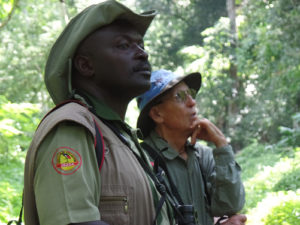 Mahogany trees, there are over 464 other tree species, 24 mammals, 300 butterflies and 9 types of primates. Chimpanzee trekking is the most popular activity here followed by nature walks. Over 600 chimps call this large forest home. A smaller community have been habituated and opened to tourism. Visitors can spot the chimps, other primates, birds by following a long trail (over 114 km) within the forest. The other primates include Olive baboons, Blue Monkeys, Black-and-White Colobus Monkeys, Red-tailed Monkeys, Grey-cheeked Mangabeys and Blue Monkeys. Being part of the wider Murchison Falls National Park conservation area means that those visiting Budongo forest have a chance to spot large mammals like buffaloes, lions and leopards as they come to the forest before going back to the plains.
Mahogany trees, there are over 464 other tree species, 24 mammals, 300 butterflies and 9 types of primates. Chimpanzee trekking is the most popular activity here followed by nature walks. Over 600 chimps call this large forest home. A smaller community have been habituated and opened to tourism. Visitors can spot the chimps, other primates, birds by following a long trail (over 114 km) within the forest. The other primates include Olive baboons, Blue Monkeys, Black-and-White Colobus Monkeys, Red-tailed Monkeys, Grey-cheeked Mangabeys and Blue Monkeys. Being part of the wider Murchison Falls National Park conservation area means that those visiting Budongo forest have a chance to spot large mammals like buffaloes, lions and leopards as they come to the forest before going back to the plains.
Budongo forest reserve is a birders paradise. Over 355 species can be found here and include African Emerald Cuckoo, African Pied, African Shrike Flycatcher, Black and White Casqued Hornbills, Black-headed Paradise Flycatcher, Blue-throated Roller, Brown Twinspot, Cameroon Sombre Greenbul, Cassin’s Hawk Eagle, Cassin’s Honeyguide, Cassin’s Spinetail, Chestnut Crowned Eremomera, Chestnut-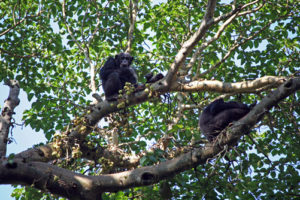 capped Flycatcher, Chocolate-backed Kingfisher, Crested Malimbe, Crowned Eagle, Dusky long-tailed Cuckoo, Forest Robin, Grey-headed Sunbird, Guinea Congo forest Biome, illadopsis puveli, Ituri Batis, Jameson’s Wattle-eye, Kingfishers, Lemon-bellied Crombec, Little Green Sunbird, Olive Green Camaroptera, parmoptila woodhousei, Piping, pitta reichenowi, Puvell’s Illadopsis, Pygmy Crakes, Sabine’s Spinetail, Slender-billed Greenbul, Speckled Tinkerbird, Western Black-headed Oriole, White-spotted Flufftail, Yellow and Grey Longbill, yellow footed fly catcher. Yellow-browned Camaroptera, Yellow-crested Woodpecker, Yellow-footed Flycatcher, Yellow-manted Weaver and Yellow-spotted Barbet.
capped Flycatcher, Chocolate-backed Kingfisher, Crested Malimbe, Crowned Eagle, Dusky long-tailed Cuckoo, Forest Robin, Grey-headed Sunbird, Guinea Congo forest Biome, illadopsis puveli, Ituri Batis, Jameson’s Wattle-eye, Kingfishers, Lemon-bellied Crombec, Little Green Sunbird, Olive Green Camaroptera, parmoptila woodhousei, Piping, pitta reichenowi, Puvell’s Illadopsis, Pygmy Crakes, Sabine’s Spinetail, Slender-billed Greenbul, Speckled Tinkerbird, Western Black-headed Oriole, White-spotted Flufftail, Yellow and Grey Longbill, yellow footed fly catcher. Yellow-browned Camaroptera, Yellow-crested Woodpecker, Yellow-footed Flycatcher, Yellow-manted Weaver and Yellow-spotted Barbet.
Budongo forest experiences two rainy and dry seasons. The rainy season is between March to May and September to November. The main dry season is between December and February.
Chimpanzees in Budongo
Chimpanzees are our closest relatives when you consider that they share more than 98% of our DNA. They are very intelligent creatures and eat a variety of foods including plants and fruits. Chimpanzees also consume meat whenever an opportunity arises. A fully grown male chimp can weigh up to 70 kilograms while females may reach 50 Kilograms. Chimps can live up to 60 years in captivity. Unlike males, female chimpanzee usually leave the community they were born in once they reach adolescence. Like humans, chimpanzees easily adapt to different environments and learn to use new tools. Because of this, chimpanzee communities differ in overall behavior depending on where they live.
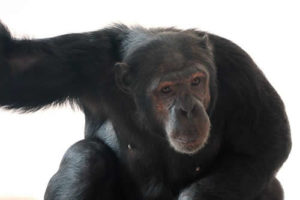 Budongo forest is one of the few remaining strongholds for chimpanzees in Uganda. The first person to study chimpanzees in Budongo was Vernon Reynolds. He was along with Adriaan Kortlandt and Jane Goodall the first primatologists to do extensive studies of chimpanzees in their natural habitat. As Uganda entered a period of political uncertainty and civil wars between 1972 and 1986, Vermon left. He returned in 1990 to find the chimpanzee population severely disseminated due to uncontrolled poaching. He found out that infant chimps were often sold to collectors outside Africa after their mothers had been shot dead. The chimp population decreased so much that by 1995, less than 55 individuals were recorded in the forest.
Budongo forest is one of the few remaining strongholds for chimpanzees in Uganda. The first person to study chimpanzees in Budongo was Vernon Reynolds. He was along with Adriaan Kortlandt and Jane Goodall the first primatologists to do extensive studies of chimpanzees in their natural habitat. As Uganda entered a period of political uncertainty and civil wars between 1972 and 1986, Vermon left. He returned in 1990 to find the chimpanzee population severely disseminated due to uncontrolled poaching. He found out that infant chimps were often sold to collectors outside Africa after their mothers had been shot dead. The chimp population decreased so much that by 1995, less than 55 individuals were recorded in the forest.
A group researchers started work in the forest with funding from the Edinburgh Zoo, RZSS and other sources. The researchers initiated a project (The Budongo Forest Project) which was later renamed Budongo Conservation Field Station (BCFS). BCFS combines conservation and research while also ensuring sustainable management of the forest reserve. BCFS encountered many challenges once work started. Like many of the other forest reserves in Uganda, Budongo forest had been encroached on by communities surrounding it. The forest margins were being used for farming while poachers put snares to trap forest antelopes and small rodents. Several chimpanzees had their hands and limbs severally mutilated by snares left behind by poachers. The population of Mahagony (a favorite hideout for the chimps) trees had reduced greatly as individuals cut them down for timber.
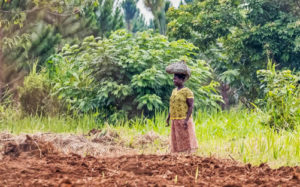 To address many of the challenges mentioned above, the project embarked on several activities which include monitoring the health of the chimps and observing behavioral data on a daily basis. The project has also helped habituate over 300 chimps while also working with communities living close to the forest to discourage them from setting dangerous snares in the forest.
To address many of the challenges mentioned above, the project embarked on several activities which include monitoring the health of the chimps and observing behavioral data on a daily basis. The project has also helped habituate over 300 chimps while also working with communities living close to the forest to discourage them from setting dangerous snares in the forest.
The project ensures that the proceeds from Eco-tourism are shared with the local community. To stop poaching for forest creatures, hunters are given goats as an alternative source of income and livelihood. These ex-poachers voluntarily help the BCFS team identity where they laid their last snares. Because of the good work of the project, the overall population of chimpanzees have increased dramatically. Poaching chimpanzees for pets has virtually been stopped.
Things to do in Budongo Forest
Chimpanzee trekking: As already discussed in detail earlier, the main activity that draws tourists to the forest is Chimpanzee trekking. Budongo forest reserve is one of the best places to track chimpanzees in Uganda. Most of the tracking takes place at Kaniyo Pabidi which is located south of the Murchison Falls National Park.
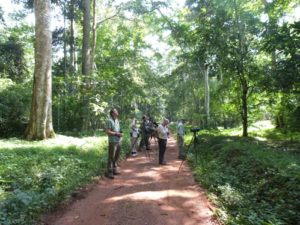 Chimpanzee trekking in Budongo usually starts with briefing from the information Centre at the Budongo Eco Lodge. The forest has well established trails to allow visitors spot the chimps as well as other smaller primates and birds. Chimpanzee trekking is done in two shifts –morning and afternoon. The Chimp communities roam very close to the Budongo Eco lodge on most days of the year. However, during certain periods of the year, they wander way in search of fruits and water. During these periods of food scarcity, finding them is not always guaranteed. The success rate of seeing chimps is still very high, only bettered by Kibale forest national park. For the best possible chance of spotting the chimps, visit during the months between October and January. Chimpanzee trekking in Budongo lasts for an average of 3 hours. After locating the chimp community, visitors are only allowed one hour with them.
Chimpanzee trekking in Budongo usually starts with briefing from the information Centre at the Budongo Eco Lodge. The forest has well established trails to allow visitors spot the chimps as well as other smaller primates and birds. Chimpanzee trekking is done in two shifts –morning and afternoon. The Chimp communities roam very close to the Budongo Eco lodge on most days of the year. However, during certain periods of the year, they wander way in search of fruits and water. During these periods of food scarcity, finding them is not always guaranteed. The success rate of seeing chimps is still very high, only bettered by Kibale forest national park. For the best possible chance of spotting the chimps, visit during the months between October and January. Chimpanzee trekking in Budongo lasts for an average of 3 hours. After locating the chimp community, visitors are only allowed one hour with them.
In order to participate in the chimpanzee trekking exercise, one needs to be in good health and free from diseases like flue or Tuberculosis. Chimps easily contract human diseases. One also needs to be at least 15 years of age to track chimpanzees. The cost of a chimpanzee permit in Budongo costs $130 after a recent change in management to Amos Wekesa. . The mimimum age for Chimpanzee Trekking in Uganda is 12 years. Chimpanzee tracking can be combine with game drives in the park in our 4 days wildlife safari in Murchison Falls package.
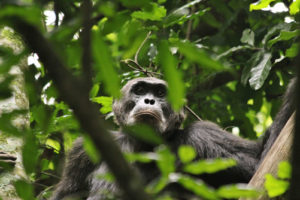 Chimpanzee Habituation Experience: Chimpanzee habituation is the process of enabling chimps to get used to human presence around them. The process takes about two years. In Budongo forest, visitors are also offered an opportunity to take part in the chimpanzee habituation process especially during periods when here are fewer visitors to the forest. The Chimpanzee habituation experience involves following a community of chimps and learning about their behavior under the guidance of senior researchers and trackers. It differs from normal chimpanzee trekking because it goes on throughout the day. Visitor are allowed a lot more time with the chimps. For the best chimpanzee habituation experience, one need good hiking boots, hand gloves, long sleeved shits/pants, sun glasses and a hat. The chimpanzee habituation experience in Budongo forest cost $160 (Price may be different as a result of a recent change in management). This amount is less than that charged in Kibale National Park. You should check out the 3 Days Chimpanzee habituation tour in Kibale National Park for comparison.
Chimpanzee Habituation Experience: Chimpanzee habituation is the process of enabling chimps to get used to human presence around them. The process takes about two years. In Budongo forest, visitors are also offered an opportunity to take part in the chimpanzee habituation process especially during periods when here are fewer visitors to the forest. The Chimpanzee habituation experience involves following a community of chimps and learning about their behavior under the guidance of senior researchers and trackers. It differs from normal chimpanzee trekking because it goes on throughout the day. Visitor are allowed a lot more time with the chimps. For the best chimpanzee habituation experience, one need good hiking boots, hand gloves, long sleeved shits/pants, sun glasses and a hat. The chimpanzee habituation experience in Budongo forest cost $160 (Price may be different as a result of a recent change in management). This amount is less than that charged in Kibale National Park. You should check out the 3 Days Chimpanzee habituation tour in Kibale National Park for comparison.
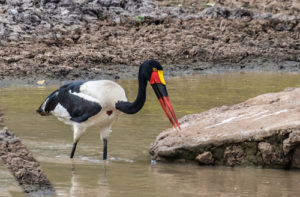 Birdwatching: Budongo forest is one of the best places for bird watching in Uganda. With the help of experienced Guides, birders can choose to go for a full or half day of bird watching. The Royal Mile found within the Busingiro area is arguably the best place to go if you want to see most of the species in a day. The Royal mile extends from the main research station up to a forestry college nearby. The rare species to look out for are the Guinea Congo forest-Biome, Pitta reichenowi, Yellow-footed Flycatcher, Illadopsis puveli and Parmoptila woodhousei. At the end of the day you should have spotted at least half of the about 360 species found in the forest area.
Birdwatching: Budongo forest is one of the best places for bird watching in Uganda. With the help of experienced Guides, birders can choose to go for a full or half day of bird watching. The Royal Mile found within the Busingiro area is arguably the best place to go if you want to see most of the species in a day. The Royal mile extends from the main research station up to a forestry college nearby. The rare species to look out for are the Guinea Congo forest-Biome, Pitta reichenowi, Yellow-footed Flycatcher, Illadopsis puveli and Parmoptila woodhousei. At the end of the day you should have spotted at least half of the about 360 species found in the forest area.
Nature Walks: In the company of armed rangers, tourists can go for nature walks deep in the forest. Visiting the beautiful Kaniyo pabidi eco-tourism Centre is highly recommended. The Centre has tall Mahagony trees that are over 70 years old. During the nature walks, you will encounter a variety of wild creatures that come to lick salt from fallen trees. After seeing enough of the forest, you can also venture out to the savanna plains and woodlands that connect to the plains of Murchison Falls National Park. Here you might see some of the larger mammals like buffaloes, elephants, lions and even leopards. In fact, these large mammals visit the forest itself frequently. You will always be in the company of armed rangers for your protection. Do not forget to carry drinking water or packed lunch.
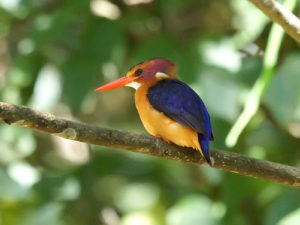 Visit other parts of the Murchison Falls National Park: Budongo forest reserve is part of the Murchison Falls National Park and offers opportunities to do activities like visiting the top of the falls, going for game drives, boat cruises and a cultural visit to the Boomu Women’s Group to see how life goes by in a rural African village. By the end of your tour of Murchison Falls National Park, Budongo forest and the nearby Ziwa Rhino Sanctuary, you would have spotted all the big 5 mammals. Check out this 2 Days Safari in Murchison Falls for more details.
Visit other parts of the Murchison Falls National Park: Budongo forest reserve is part of the Murchison Falls National Park and offers opportunities to do activities like visiting the top of the falls, going for game drives, boat cruises and a cultural visit to the Boomu Women’s Group to see how life goes by in a rural African village. By the end of your tour of Murchison Falls National Park, Budongo forest and the nearby Ziwa Rhino Sanctuary, you would have spotted all the big 5 mammals. Check out this 2 Days Safari in Murchison Falls for more details.
How to reach Budongo Central Forest Reserve
Budongo forest is found in North-western Uganda. It takes 3 hours to reach the reserve from Kampala. From Kampala, one needs to first drive to Masindi town before heading to the forest reserve. Entrance to Budongo Forest reserve costs $40 per person.
Accommodation in Budongo Central Forest Reserve
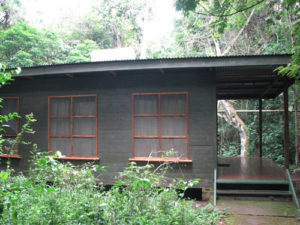 Visitors to Budongo forest reserve have plenty of options for accommodation. The final choice of accommodation depends on one’s budget. The lodges and hotels can be got within the forest reserve, in Masindi town or further at the Murchison Falls National Park. For those who love outdoor camping, it can be arranged within the reserve. The Research Centre in Budongo forest also offers simple rooms at affordable rates:
Visitors to Budongo forest reserve have plenty of options for accommodation. The final choice of accommodation depends on one’s budget. The lodges and hotels can be got within the forest reserve, in Masindi town or further at the Murchison Falls National Park. For those who love outdoor camping, it can be arranged within the reserve. The Research Centre in Budongo forest also offers simple rooms at affordable rates:
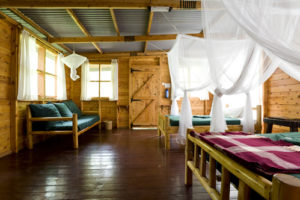 Budongo Eco lodge: Budongo Eco Lodge is a budget lodge built within the Budongo forest reserve. The lodge is 30 km away from the town of Masindi and offers a perfect atmosphere for relaxation and in a tranquil environment. Budongo Eco lodge offers comfortable special cabins with balconies and also dormitory rooms. The dorm rooms are spacious and designed to be used by large groups of tourists. The lodge has a restaurant where residents can order for both local and international foods. While at the lodge you can participate in activities like chimpanzee trekking, birding, chimpanzee habituation experience and nature walks. Those who are interested in local souvenir can go to the Visitor Centre and purchase locally made art pieces and gifts.
Budongo Eco lodge: Budongo Eco Lodge is a budget lodge built within the Budongo forest reserve. The lodge is 30 km away from the town of Masindi and offers a perfect atmosphere for relaxation and in a tranquil environment. Budongo Eco lodge offers comfortable special cabins with balconies and also dormitory rooms. The dorm rooms are spacious and designed to be used by large groups of tourists. The lodge has a restaurant where residents can order for both local and international foods. While at the lodge you can participate in activities like chimpanzee trekking, birding, chimpanzee habituation experience and nature walks. Those who are interested in local souvenir can go to the Visitor Centre and purchase locally made art pieces and gifts.
